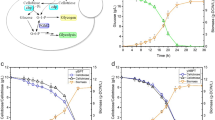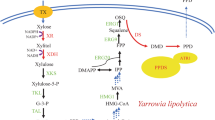Abstract
Phloroglucinol is an important chemical intermediate which has been tentatively produced by engineered bacteria. However, its biosynthesis in industry is limited due to its natural antibacterial activity. Our study firstly selected Yarrowia lipolytica as the chassis strain, which was verified to be tolerable to phloroglucinol. Then the gene of type III polyketone synthase PhlD (the key biosynthetic gene) was overexpressed to facilitate phloroglucinol production with a concentration of 107.4 mg/L. Furthermore, we introduced the prokaryotic nanocompartment to assist the intracellular catalytic activity. The results showed that the concentration of phloroglucinol was increased by about 2.5 times, indicating this multifunctional nanocompartment is orthogonal to the physiological activities of Y. lipolytica. Additionally, fermentations with xylose and lignocellulosic hydrolysates as the carbon source were performed with the engineered Y. lipolytica, resulting in a total concentration of 580.2 mg/L and 328.9 mg/L, respectively. These findings revealed the potential of Y. lipolytica in phloroglucinol production and provided an effective nanocompartment strategy to improve the catalytic activity of the enzyme for boosting phloroglucinol production.
Key points
• The first time to select and use Y. lipolytica to produce phloroglucinol.
• Successful construction of prokaryotic nanocompartment in Y. lipolytica to increase production of phloroglucinol.
• Lignocellulose hydrolysate is used as a substrate in fermentation.





Similar content being viewed by others
Data availability
All data generated or analyzed during this study are included in this published article (and its supplementary information files).
References
Achkar J, Xian M, Zhao HM, Frost JW (2005) Biosynthesis of phloroglucinol. J Am Chem Soc 127(15):5332–5333. https://doi.org/10.1021/ja042340g
Barth G, Gaillardin C (1997) Physiology and genetics of the dimorphic fungus Yarrowia lipolytica. FEMS Microbiol Rev 19(4):219–237. https://doi.org/10.1111/j.1574-6976.1997.tb00299.x
Cao YJ, Jiang XL, Zhang RB, Xian M (2011) Improved phloroglucinol production by metabolically engineered Escherichia coli. Appl Microbiol Biotechnol 91(6):1545–1552
Cheah LC, Stark T, Adamson LSR, Abidin RS, Lau YH, Sainsbury F, Vickers CE (2021) Artificial self-assembling nanocompartment for organizing metabolic pathways in yeast. ACS Synth Biol 10(12):3251–3263. https://doi.org/10.1021/acssynbio.1c00045
Chen DC, Beckerich JM, Gaillardin C (1997) One-step transformation of the dimorphic yeast Yarrowia lipolytica. Appl Microbiol Biotechnol 48(2):232–235. https://doi.org/10.1007/s002530051043
Demchuk AM, Patel TR (2020) The biomedical and bioengineering potential of protein nanocompartments. Biotechnol Adv 41:107547. https://doi.org/10.1016/j.biotechadv.2020.107547
El Gaafary M, Saber FR, Mahrous EA, Ashour RM, Okba MM, Jin L, Lang SJ, Schmiech M, Simmet T, Syrovets T (2022) The phloroglucinol calcitrinone A, a novel mitochondria-targeting agent, induces cell death in breast cancer cells. Food Chem Toxicol: an International Journal Published for the British Industrial Biological Research Association 162:112896–112896. https://doi.org/10.1016/j.fct.2022.112896
Gabashvili AN, Chmelyuk NS, Efremova MV, Malinovskaya JA, Semkina AS, Abakumov MA (2020) Encapsulins-bacterial protein nanocompartments: structure, properties, and application. Biomolecules 10(6):966. https://doi.org/10.3390/biom10060966
Gietz RD, Woods RA (2002) Transformation of yeast by lithium acetate/single-stranded carrier DNA/polyethylene glycol method. In: Guthrie C, Fink GR (eds) Guide to yeast genetics and molecular and cell biology, Pt B. Methods in Enzymol 350:87–96. https://doi.org/10.1016/s0076-6879(02)50957-5
Jones JA, Giessen TW (2021) Advances in encapsulin nanocompartment biology and engineering. Biotechnol Bioeng 118(1):491–505. https://doi.org/10.1002/bit.27564
Jung H, Kim HJ, Choi ES, Lee JY, Park KS, Cho KB, Lee YJ (2021) Effectiveness of oral phloroglucinol as a premedication for unsedated esophagogastroduodenoscopy: a prospective, double-blinded, placebo-controlled, randomized trial. PLoS ONE 16(8):e0255016. https://doi.org/10.1371/journal.pone.0255016
Lau YH, Giessen TW, Altenburg WJ, Silver PA (2018) Prokaryotic nanocompartments form synthetic organelles in a eukaryote. Nat Commun 9:1311. https://doi.org/10.1038/s41467-018-03768-x
Ledesma-Amaro R, Lazar Z, Rakicka M, Guo ZP, Fouchard F, Crutz-Le Coq AM, Nicaud JM (2016) Metabolic engineeringof Yarrowia lipolytica to produce chemicals and fuels from xylose. Metab Eng 38:115–124. https://doi.org/10.1016/j.ymben.2016.07.001
Li H, Alper HS (2016) Enabling xylose utilization in Yarrowia lipolytica for lipid production. Biotechnol J 11(9):1230–1240. https://doi.org/10.1002/biot.201600210
McHugh CA, Fontana J, Nemecek D, Cheng N, Aksyuk AA, Heymann JB, Winkler DC, Lam AS, Wall JS, Steven AC, Hoiczyk E (2014) A virus capsid-like nanocompartment that stores iron and protects bacteria from oxidative stress. EMBO J 33(17):1896–1911. https://doi.org/10.15252/embj.201488566
Nilvebrant NO, Reimann A, Larsson S, Jonsson LJ (2001) Detoxification of lignocellulose hydrolysates with ion-exchange resins. Appl Biochem Biotechnol 91–3:35–49. https://doi.org/10.1385/abab:91-93:1-9:35
Platania V, Douglas TEL, Zubko MK, Ward D, Pietryga K, Chatzinikolaidou M (2021) Phloroglucinol-enhanced whey protein isolate hydrogels with antimicrobial activity for tissue engineering. Mater Sci Eng C Mater Biol Appl 129:112412. https://doi.org/10.1016/j.msec.2021.112412
Rao G, Lee J-K, Zhao H (2013) Directed evolution of phloroglucinol synthase PhlD with increased stability for phloroglucinol production. Appl Microbiol Biotechnol 97(13):5861–5867. https://doi.org/10.1007/s00253-013-4713-4
Rodriguez JM, Allende-Ballestero C, Cornelissen JJLM, Caston JR (2021) Nanotechnological applications based on bacterial encapsulins. Nanomaterials 11(6):1467. https://doi.org/10.3390/nano11061467
Sun T, Yu Y, Wang K, Ledesma-Amaro R, Ji X-J (2021) Engineering Yarrowia lipolytica to produce fuels and chemicals from xylose: a review. Bioresour Technol 337:125484. https://doi.org/10.1016/j.biortech.2021.125484
Takamura Y, Nomura G (1988) Changes in the intracellular concentration of acetyl-CoA and malonyl-CoA in relation to the carbon and energy metabolism of Escherichia coli K12. J Gen Microbiol 134(8):2249–2253
Wu XB, Huang GF, Bai LP, Long MN, Chen QX (2014) Enhanced hydrogen production from xylose and bamboo stalk hydrolysate by overexpression of xylulokinase and xylose isomerase in Klebsiella oxytoca HP1. Int J Hydrogen Energy 39(1):221–230. https://doi.org/10.1016/j.ijhydene.2013.10.078
Xu X, Xian M, Liu H (2017) Efficient conversion of acetate into phloroglucinol by recombinant Escherichia coli. RSC Adv 7(80):50942–50948. https://doi.org/10.1039/c7ra09519h
Yang F, Cao Y (2012) Biosynthesis of phloroglucinol compounds in microorganisms-review. Appl Microbiol Biotechnol 93(2):487–495. https://doi.org/10.1007/s00253-011-3712-6
Yocum HC, Pham A, Da Silva NA (2021) Successful enzyme colocalization strategies in yeast for increased synthesis of non-native products. Front Bioeng Biotechnol 9:606795. https://doi.org/10.3389/fbioe.2021.606795
Zha WJ, Rubin-Pitel SB, Zhao HM (2008) Exploiting genetic diversity by directed evolution: molecular breeding of type III polyketide synthases improves productivity. Mol Biosyst 4(3):246–248. https://doi.org/10.1039/b717705d
Zha WJ, Rubin-Pitel SB, Shao ZY, Zhao HM (2009) Improving cellular malonyl-CoA level in Escherichia coli via metabolic engineering. Metab Eng 11(3):192–198. https://doi.org/10.1016/j.ymben.2009.01.005
Zhang F, Lai Q, Lai W, Li M, Jin X, Ye L (2022) Phloroglucinol derivatives as anti-tumor agents: synthesis, biological activity evaluation and molecular docking studies. Med Chem Res 31(1):165–176. https://doi.org/10.1007/s00044-021-02828-0
Zhang R, Cao Y, Liu W, Xian M, Liu H (2017a) Improving phloroglucinol tolerance and production in Escherichia coli by GroESL overexpression. Microb Cell Fact 16:227. https://doi.org/10.1186/s12934-017-0839-x
Zhang R, Liu W, Cao Y, Xu X, Xian M, Liu H (2017b) An in vitro synthetic biosystem based on acetate for production of phloroglucinol. BMC Biotechnol 17:66. https://doi.org/10.1186/s12896-017-0376-z
Zhou LL, Wen ZQ, Wang ZD, Zhang YW, Ledesma-Amaro R, Jin MJ (2020) Evolutionary engineering improved D-glucose/xylose cofermentation of Yarrowia lipolytica. Ind Eng Chem Res 59(39):17113–17123. https://doi.org/10.1021/acs.iecr.0c00896
Acknowledgements
The authors thank the public platform of Laboratory of Industrial Catalysis& Metabolic Engineering (Nanjing Normal University) for technical support.
Funding
This research was financially supported by the National Natural Science Foundation of China (8220102395), the Natural Science Foundation of Jiangsu Province of China(BK20220375), and the Jiangsu provincial colleges of Natural Science General Program(22KJB350007).
Author information
Authors and Affiliations
Contributions
TZ and WZ designed and finished the project, and ZL and WY contributed to the data analysis and manuscript writing. LY and HH assisted in this experiment and helped complete the manuscript revision.
Corresponding authors
Ethics declarations
Ethical approval
This article does not contain any studies with human participants or animals performed by any of the authors.
Conflict of interest
The authors declare no competing interests.
Additional information
Publisher's note
Springer Nature remains neutral with regard to jurisdictional claims in published maps and institutional affiliations.
Supplementary Information
Below is the link to the electronic supplementary material.
Rights and permissions
Springer Nature or its licensor (e.g. a society or other partner) holds exclusive rights to this article under a publishing agreement with the author(s) or other rightsholder(s); author self-archiving of the accepted manuscript version of this article is solely governed by the terms of such publishing agreement and applicable law.
About this article
Cite this article
Tu, Z., Zhou, L., Wu, Y. et al. Construction of prokaryotic nanocompartment in Yarrowia lipolytica to assist phloroglucinol production. Appl Microbiol Biotechnol 107, 5341–5349 (2023). https://doi.org/10.1007/s00253-023-12668-0
Received:
Revised:
Accepted:
Published:
Issue Date:
DOI: https://doi.org/10.1007/s00253-023-12668-0




